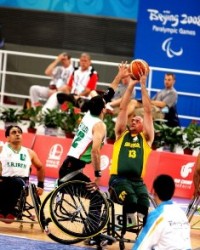 Within the framework of the research project (AiF-Nr. 17377 N), scientists at the Hohenstein Institute in Bönnigheim are aiming to optimise functionality and comfort of sportswear for wheelchair users. Project leader Anke Klepser ascertained the physical dimensions of male wheelchair basket ball players and hand bikers: “By choosing these particular sports we are covering both indoor and outdoor sports, which means that our research results can also be adapted to other sports disciplines.
Within the framework of the research project (AiF-Nr. 17377 N), scientists at the Hohenstein Institute in Bönnigheim are aiming to optimise functionality and comfort of sportswear for wheelchair users. Project leader Anke Klepser ascertained the physical dimensions of male wheelchair basket ball players and hand bikers: “By choosing these particular sports we are covering both indoor and outdoor sports, which means that our research results can also be adapted to other sports disciplines.
“A further benefit is that we are examining two different body postures, the more horizontal body position of the hand bikers and the upright sitting position of the wheelchair basketball players and this enables any results to be easily transferred to other sports.” The test persons were measured once in a stationary 3D Bodyscanner in their usual wheelchair and then also with a handscanner in their respective sports wheelchair.
Back in the 1980s clothing technology experts had already captured the physical dimensions of wheelchair users in order to improve the fit of everyday clothing. With the assistance of today's 3D scanner technology first of all the body can be captured in full and then a virtual twin (avatar) can be compiled which can be used to measure on the computer, as required, individual body measurements such as the back, legs or arms.
An important objective of the project is to use the measurement data to optimise the cuts and seam lines of sportswear. But also the physiological comfort, or in other words, the ability of the textiles to absorb body sweat and divert it away from the body as well as the heat insulation of the materials should also be adapted to the specific requirements of the athletes. Skin irritations caused by mechanical actions such as intensive friction of the arms on the upper body should be minimised in the demonstration/functional samples that are to be developed.
The sitting position of wheelchair users in particular creates specific requirements for clothing cuts. In order to achieve a horizontal waistband fit, the back part of the trousers must be cut longer than the front. The horizontal position of the handbikers on the other hand requires the exact opposite in functionalities if the sportswear is to sit in the optimum position. In the majority of wheelchair athletes the upper body and arms are very muscular which must be taken into consideration in the design of shirts and jackets. To create a good fit with extensive freedom of movement, the clothing items should therefore have adapted seam lines.
In addition to the anatomical specifics, as part of their project, the researchers also collated those special requirements which arise from the sports commitment of the athletes. Therefore, in addition to the 3D scanner measurements, Anke Klepser has also conducted a survey to collate the optimisation wishes of the test persons. For instance, the hand bikers said that they would like to see a narrow lower leg trouser width which would offer them better head wind protection.
The scientists also had to consider the specific requirements of disabled athletes in relation to the diversion of body sweat, also known as clothing moisture management. Due to the position of the back or back of the thigh which is in close contact with the hand bike or wheel chair, moisture can very quickly get trapped. This could be avoided through the use of various suitable materials and functional designs in these areas (Comfort-Mapping)
In contrast to this, depending on the type and degree of the spinal cord injury, for the majority of wheelchair athletes, the paralysis of the extremities is also linked to a restricted functionality of the body's own temperature control.
For example, quadriplegics whose legs and arms are affected to a greater or lesser extent by the paralysis, do not sweat or only sweat to a limited extent and run the risk, especially in the case of very high external temperatures and/or high physical exertion, of suffering a circulatory collapse due to the body overheating.
Water applied externally to the clothing can help in such cases by ensuring the necessary cooling through evaporation. Anke Klepser and her team also had to consider other specific aspects in their research work. "The clothing requirements for wheelchair athletes are extremely variable and complex.
"We hope that our data and information will form the basis for many optimised products which will make life easier for the athletes and will support them appropriately in their outstanding achievements. It is expected that the results of the project will be available for interested manufacturers from early 2014.





